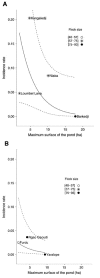Rift Valley fever in small ruminants, Senegal, 2003
- PMID: 16318720
- PMCID: PMC3367374
- DOI: 10.3201/eid1111.050193
Rift Valley fever in small ruminants, Senegal, 2003
Abstract
During the 2003 rainy season, the clinical and serologic incidence of Rift Valley fever was assessed in small ruminant herds living around temporary ponds located in the semi-arid region of the Ferlo, Senegal. No outbreak was detected by the surveillance system. Serologic incidence was estimated at 2.9% (95% confidence interval 1.0-8.7) and occurred in 5 of 7 ponds with large variations in the observed incidence rate (0%-20.3%). The location of ponds in the Ferlo Valley and small ponds were correlated with higher serologic incidence (p = 0.0005 and p = 0.005, respectively). Rift Valley fever surveillance should be improved to allow early detection of virus activity. Ruminant vaccination programs should be prepared to confront the foreseeable higher risks for future epidemics of this disease.
Figures



References
-
- Fontenille D, Traore-Lamizana M, Zeller HG, Mondo M, Diallo M, Digoutte JP. Short report: Rift Valley fever in western Africa: isolations from Aedes mosquitoes during an interepizootic period. Am J Trop Med Hyg. 1995;52:403–4. - PubMed
Publication types
MeSH terms
Substances
LinkOut - more resources
Full Text Sources
